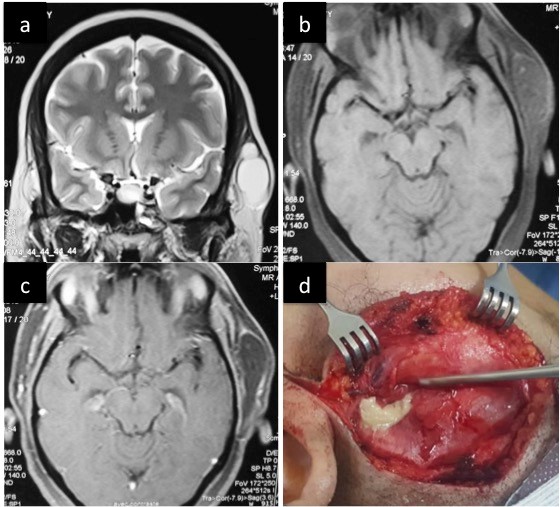A Rare Case of Temporal Scalp Dermoidcyst with No Intracranial Extension
Hatim B1* and Adil A2
1Department of Neurosurgery, Avicenne Military Hospital, Marrakech, Morocco and Cady Ayyad University, Marrakech, Morroco
2Department of Plastic and maxilla-facial surgery, Avicenne Military Hospital of Marrakech, Marrakech, Morocco and Cady Ayyad University, Marrakech, Morroco
Received Date: 05/07/2020; Published Date: 28/07/2020
*Corresponding author: Hatim Belfquih, Department of Neurosurgery, Avicenne Military Hospital, 40000, Marrakech, Morocco. Tel: +(212) 661338623; E-mail: hatimbelfquih@gmail.com
Case Report
We report a case of 37-year-old female patient presented with temporal scalp swelling since birth. The swelling increased in size very slowly and progressively. On examination, there was a soft, fluidfilledlesion over the temporal bone, which was nontender and nonpulsatile. There was no bruit over the swelling. Magnetic resonance imaging of the brain revealed extracranial well defined cystics welling over the left temporal bonewith no intracranial extension, measuring approximately 20×45×30 mm in transverse, anteriorposterior, and craniocaudal dimensions. It was cystic in appearance, with hyperintense signals on T2-weighted sequence, with no flow voids (Figure 1a) and hypointense signals on T1weighted sequences (Figure 1b) showing no surrounding edema on fluid-attenuated inversion recovery (FLAIR). There was nocontrast enhancement (Figure 1c). Intraoperatively, a soft, cystic, fluid filledlesion over temporal bone, which was densely adherent to underlying tissue (Figure 1d). Cyst was excised completely with no postoperative complications. On histopathology it was dermoidcyst.
Dermoidcysts are considered congenital lesions, but not all of them are diagnosed at birth [1]. Dermoidcysts are benign soft tissue tumors that develop from abnormal sequestration and inclusion of the surface ectoderm along the lines of skin fusion during embryologic development [2]. In the literature, midline scalp cystspresent a higherprobability of intracranial extension becausethey are on a line of embryonic fusion. Early resection may avoid more extensive surgery, and a shorter skin incision withlessrisk of wound infection mayallow an improved cosmetic outcome [3].

Conflict of Interest
No conflicts of interest.
References:
- Orozco-Covarrubias L, Lara-Carpio R, Saez-De- Ocariz M, Duran-McKinster C, Palacios-Lopez C, et al. Dermoidcysts: a report of 75 pediatric patients. Pediatr Dermatol. 2013;30:706-711.
- Reissis D, Pfaff MJ, Patel A, Steinbacher DM. Craniofacialdermoidcysts: histologicalanalysis and inter-sitecomparison. Yale J Biol Med. 2014;87:349-357.
- Khalid S, Ruge J. Considerations in the management of congenital cranial dermoidcysts. J Neurosurg. 2017;20:30-34.

